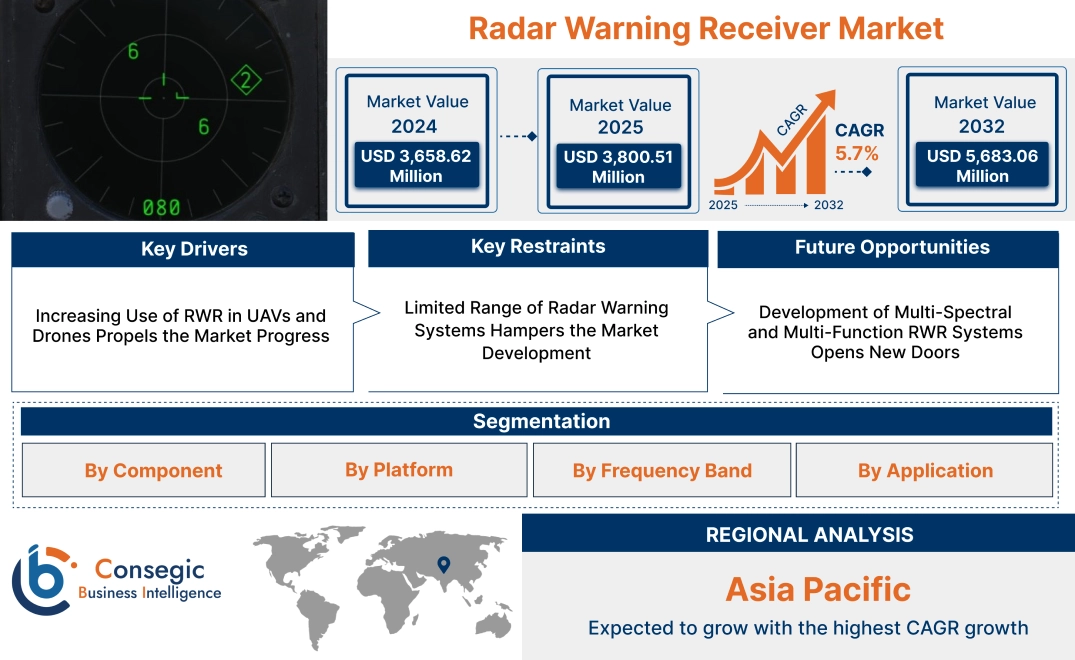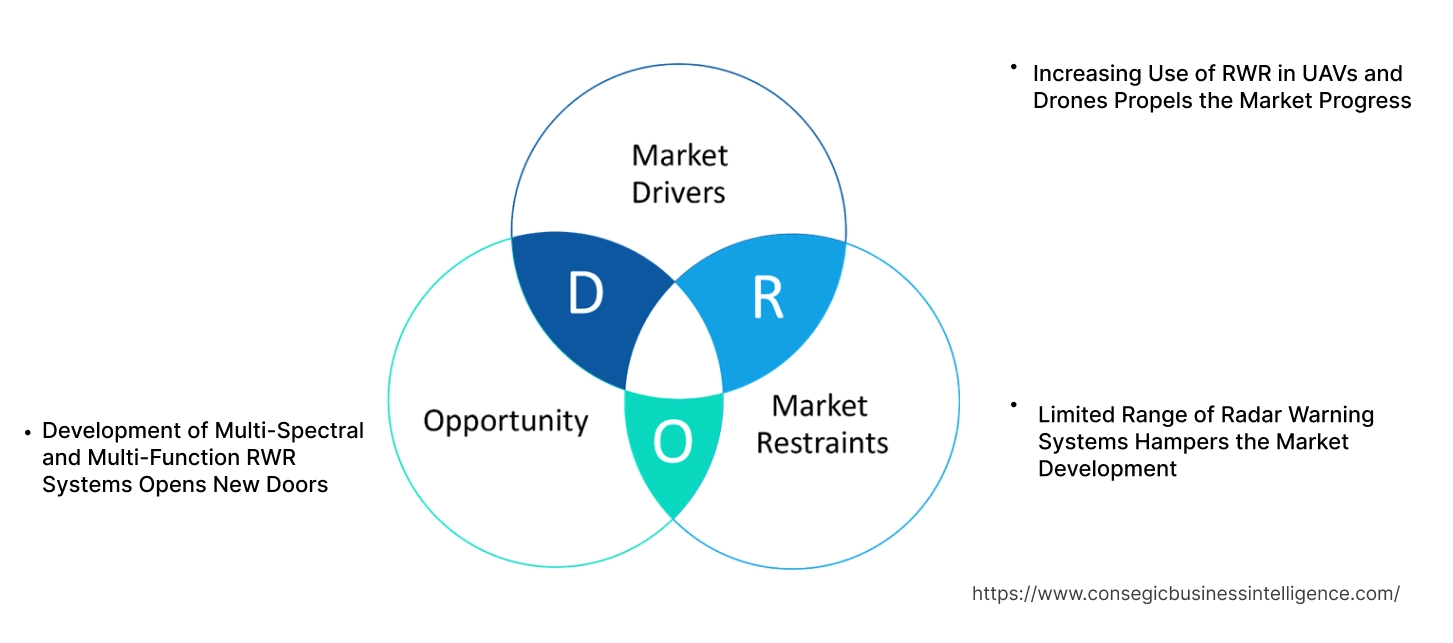Radar Warning Receiver Market Size:
Radar Warning Receiver Market size is estimated to reach over USD 5,683.06 Million by 2032 from a value of USD 3,658.62 Million in 2024 and is projected to grow by USD 3,800.51 Million in 2025, growing at a CAGR of 5.7% from 2025 to 2032.
Radar Warning Receiver Market Scope & Overview:
A radar warning receiver is an advanced electronic system designed to detect and identify radar signals emitted by potential threats, such as enemy aircraft, missiles, or ground-based radar systems. These systems provide critical situational awareness to military aircraft, naval vessels, and ground vehicles, enabling timely evasive actions and countermeasures. They are an essential component of modern electronic warfare strategies.
These warning receivers are equipped with sensors, processors, and display units to analyze incoming radar frequencies, determine the type of threat, and alert operators in real time. These systems are designed to operate in challenging environments, offering high sensitivity and accuracy even in dense electromagnetic spectrums. They are adaptable to a range of platforms, including fighter jets, naval ships, and armored vehicles.
End-users include defense organizations, military contractors, and aerospace manufacturers seeking advanced solutions to enhance threat detection and survivability. The warning receivers play a pivotal role in modernizing defense systems and supporting mission-critical operations.
Key Drivers:
Increasing Use of RWR in UAVs and Drones Propels the Market Progress
The growing adoption of unmanned aerial vehicles (UAVs) and drones for military surveillance, reconnaissance, and combat operations is driving the increasing integration of radar warning receivers (RWR) into these platforms. UAVs, often deployed in hostile environments, face threats from radar-guided missile systems and enemy detection networks. The integration of RWR systems in these unmanned platforms enables them to detect and analyze radar signals, providing crucial situational awareness and early warning in contested airspace. RWR-equipped UAVs effectively avoid radar detection, alert operators to the presence of potential threats, and take countermeasures such as evasive maneuvers or communication jamming. This enhances the UAV’s survivability, operational effectiveness, and mission success, making RWR a vital component for modern unmanned systems. As the use of drones in military operations expands, the demand for RWR integration in UAVs will continue to rise, strengthening defense capabilities in a rapidly evolving landscape. Thus, the aforementioned factors are driving the radar warning receiver market growth.
Key Restraints:
Limited Range of Radar Warning Systems Hampers the Market Development
The effectiveness of radar warning receivers (RWR) is inherently limited by their range, which is a significant restraint. RWR systems are designed to detect radar emissions from potential threats, but their ability to detect and identify threats depends on the power and frequency of the radar signals. In environments with long-range radar threats or low-power radar signals, RWR systems do not detect threats in time for countermeasures or evasive actions. Additionally, the range of detection is significantly reduced in high-density electromagnetic environments, where signal interference from multiple sources mask or distort radar signals. As threats become more advanced and stealth technologies evolve, the range limitations of RWR systems compromise their ability to provide timely warnings, thereby limiting their effectiveness in modern warfare scenarios. This necessitates continuous advancements in detection range and sensitivity to address evolving radar threat capabilities. In conclusion, the limited range is hindering the radar warning receiver market demand.
Future Opportunities :
Development of Multi-Spectral and Multi-Function RWR Systems Opens New Doors
The development of multi-spectral and multi-function radar warning receivers (RWR) represents a significant advancement in electronic warfare capabilities. These systems are designed to detect a broad range of threats across various radar frequencies, enhancing their ability to provide comprehensive protection for military platforms on air, land, and sea. Multi-spectral RWRs simultaneously detect and analyze different types of radar emissions, including those from ground-based radar, airborne radar, and missile guidance systems. This capability improves threat identification, reduces the risk of radar signal evasion, and enables more effective countermeasures. Multi-function RWR systems further enhance their versatility by integrating additional functionalities such as signal jamming and threat classification, which allow for adaptive responses to a variety of radar threats. The ability to provide integrated defense across diverse domains makes these advanced systems highly valuable, contributing to more robust and cohesive defense strategies across multiple platforms. Therefore, the above mentioned factors are creating substantial radar warning receiver market opportunities.
Radar Warning Receiver Market Segmental Analysis :
By Component:
Based on components, the market is categorized into antennas, receivers, processors, displays, power supply units, and others.
The receivers segment accounted for the largest revenue of the total radar warning receiver market share in 2024.
- Receivers are critical for detecting and identifying radar emissions, providing accurate situational awareness in combat environments.
- The segment’s dominance is driven by advancements in signal processing technologies that enhance sensitivity and detection capabilities.
- Military and defense industry increasingly adopt advanced receivers to counter sophisticated radar systems, boosting the segment.
- Thus, the analysis of segmental trends depicts that growing investments in electronic warfare technologies further reinforce the dominance of receivers fueling the radar warning receiver market expansion.
The processors segment is expected to register the fastest CAGR during the forecast period.
- Processors play a pivotal role in analyzing and interpreting radar signals, enabling timely threat identification and response.
- The increasing integration of artificial intelligence and machine learning in radar systems drives the adoption of advanced processors.
- The segment benefits from the rising need for high-speed data processing to improve the effectiveness of radar warning receivers.
- As per the radar warning receiver market analysis, demand from emerging defense markets for modernized radar systems contributes to the rapid growth of the processors segment.
By Platform:
The market is segmented into ground-based, airborne, naval, space-based, and others.
The airborne segment held the largest revenue share of the total radar warning receiver market share in 2024.
- Airborne platforms are widely used in combat aircraft and UAVs for detecting radar threats during missions.
- The segment benefits from the increasing adoption of advanced radar systems in fighter jets to counter evolving threats.
- Continuous upgrades in airborne radar warning technologies to support electronic warfare capabilities bolster the segment.
- As per the radar warning receiver market trends, military modernization programs worldwide drive the deployment of radar warning systems in air platforms, sustaining its dominance.
The space-based segment is projected to grow at the fastest CAGR during the forecast period.
- Space-based platforms are gaining traction for their ability to provide wide-area surveillance and early warning.
- Increased focus on satellite-based defense applications, including missile detection, fuels demand for space-based radar warning receivers.
- Technological advancements in miniaturized sensors and satellite systems support the segment’s rapid expansion.
- The rising need for space situational awareness amid growing space militarization drives growth in this segment, further fueling the radar warning receiver market expansion.
By Frequency Band:
The market is divided into Ka-Band (27–40 GHz), K-Band (18–27 GHz), Ku-Band (12-18 GHz), X-Band (8–12 GHz), C-Band (4–8 GHz), S-Band (2–4 GHz), L-Band (1–2 GHz), and others.
The X-Band segment accounted for the largest revenue share in 2024.
- X-Band is extensively used in radar systems for its high resolution and accuracy in tracking and detecting targets.
- Military applications, including missile defense and surveillance, heavily rely on X-Band radar warning receivers, boosting the segment.
- The segment benefits from advancements in X-Band radar technologies, improving their effectiveness in adverse weather conditions.
- Thus, growing defense budgets and investments in advanced radar systems further support the dominance of the X-Band segment, driving the radar warning receiver market growth.
The Ka-Band segment is expected to exhibit the fastest CAGR during the forecast period.
- Ka-Band offers higher frequencies, enabling precise tracking and smaller equipment sizes, which are ideal for modern applications.
- The rising adoption of Ka-Band in advanced electronic warfare systems and airborne platforms drives its growth.
- Demand for high-frequency radar systems for critical defense operations contributes to the rapid expansion of the segment.
- As per the radar warning receiver market analysis, innovations in Ka-Band radar technologies for space and naval applications further bolster growth.
By Application:
The market is categorized into early warning systems, electronic warfare, surveillance, and target acquisition.
The electronic warfare segment held the largest revenue of 42.5% share in 2024.
- Radar warning receivers are integral to electronic warfare operations, providing critical situational awareness and threat detection.
- The segment’s dominance is driven by the increasing adoption of electronic warfare systems to counter advanced radar threats.
- Investments in modernizing defense capabilities and electronic warfare technologies bolster the growth of this segment.
- As per the radar warning receiver market trends, the integration of these receivers with AI-based systems enhances their effectiveness, further supporting the segment’s dominance.
The surveillance segment is anticipated to grow at the fastest CAGR during the forecast period.
- Surveillance applications are witnessing high demand due to the need for constant monitoring of potential threats in military operations.
- The segment benefits from advancements in radar warning systems that provide real-time data and improved detection accuracy.
- Growing cross-border tensions and geopolitical instabilities drive the adoption of radar warning receivers for surveillance.
- As per segmental trends analysis, the rising deployment of radar systems in unmanned platforms for long-range surveillance further propels growth, contributing to the radar warning receiver market demand.
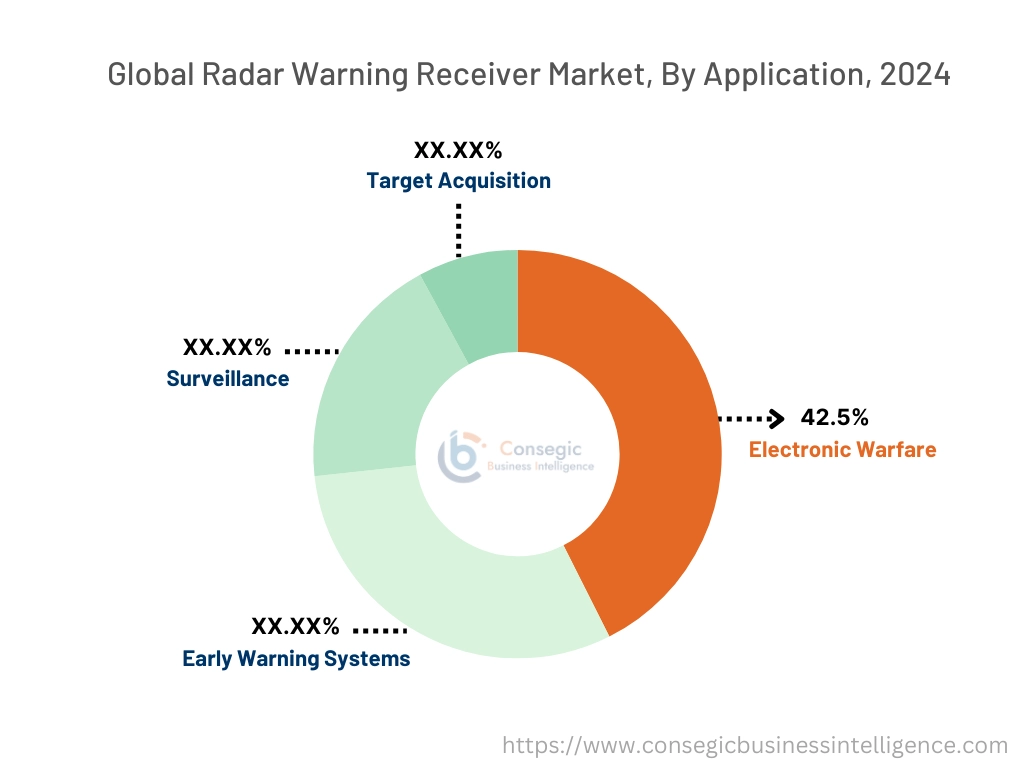
Regional Analysis:
The regions covered are North America, Europe, Asia Pacific, the Middle East and Africa, and Latin America.
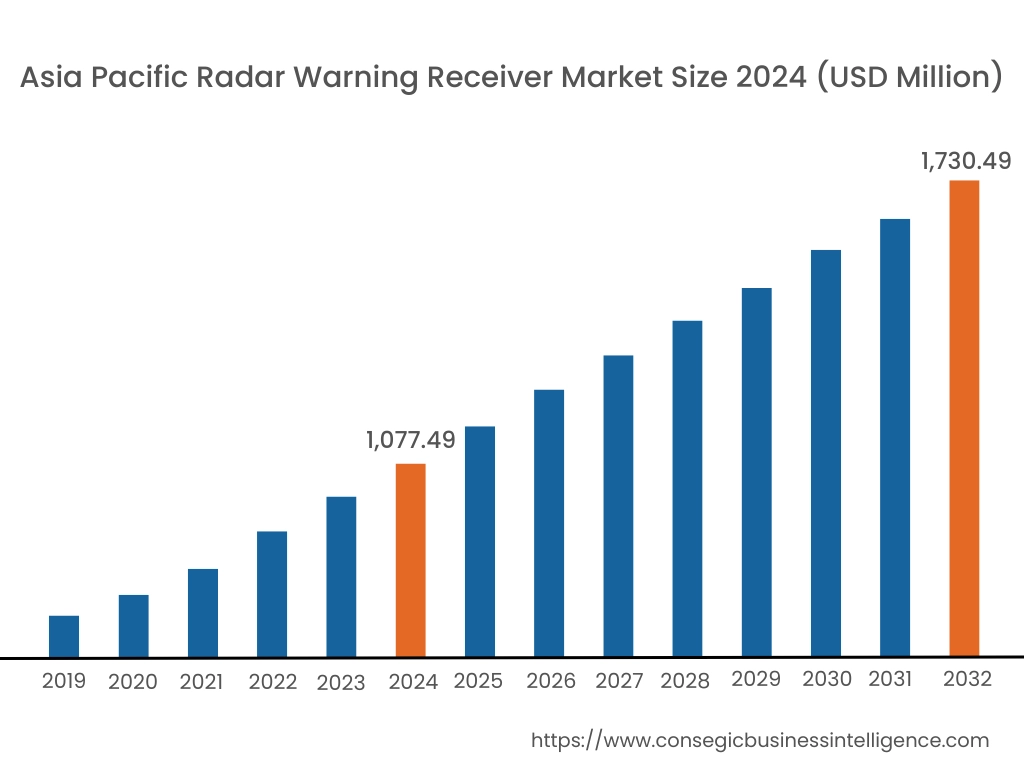
Asia Pacific region was valued at USD 1,077.49 Million in 2024. Moreover, it is projected to grow by USD 1,122.45 Million in 2025 and reach over USD 1,730.49 Million by 2032. Out of this, China accounted for the maximum revenue share of 34.7%. The Asia-Pacific region is witnessing a surge in the adoption of RWR systems, propelled by increasing defense expenditures and the induction of advanced military platforms. Countries such as China, India, and Japan are focusing on integrating RWR technologies to enhance their defense capabilities. A prominent trend is the development of indigenous technologies to reduce reliance on foreign suppliers. Analysis suggests that regional security dynamics and technological advancements are key factors influencing the market in this area.
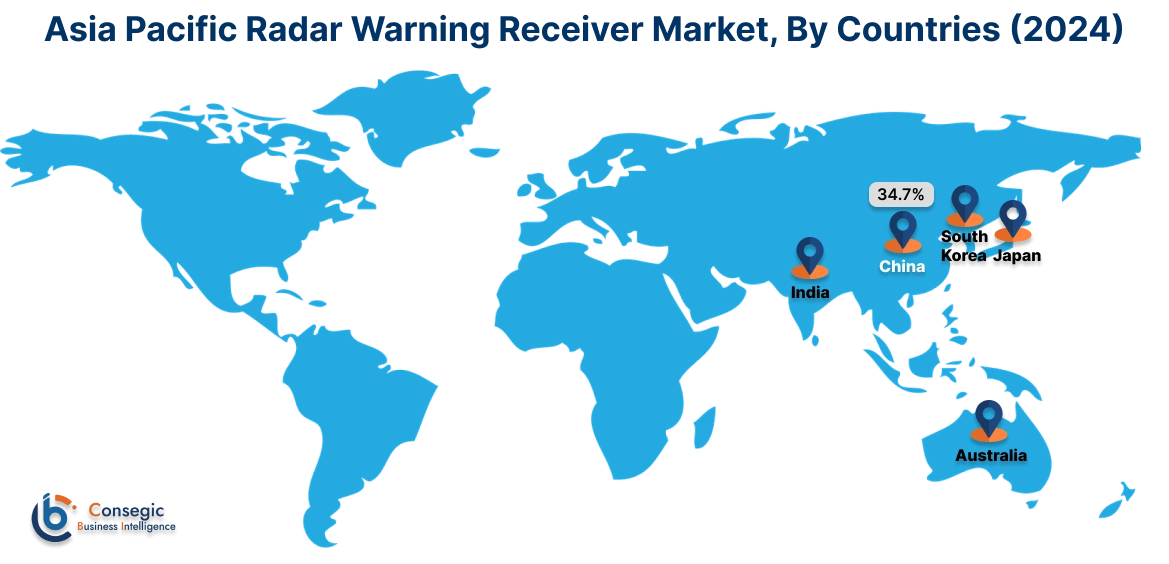
North America is estimated to reach over USD 1,841.88 Million by 2032 from a value of USD 1,213.59 Million in 2024 and is projected to grow by USD 1,258.25 Million in 2025. This region holds a substantial share of the RWR market, driven by the United States' emphasis on enhancing defense capabilities through advanced technologies. The integration of sophisticated RWR systems into military platforms is a notable trend, aiming to provide real-time threat detection and improved situational awareness. Analysis indicates that ongoing investments in research and development, coupled with modernization programs, are driving the radar warning receiver market opportunities in North America.
European nations, including the United Kingdom, France, and Germany, are actively investing in RWR technologies to bolster their defense systems. A significant trend is the collaboration among European defense manufacturers to develop sophisticated RWR solutions tailored for various military industry applications.
In the Middle East, nations are prioritizing the enhancement of their military capabilities, leading to investments in advanced RWR systems. The focus is on equipping existing and new military platforms with state-of-the-art technologies to mitigate risks during operations. However, political instability and economic diversification efforts in certain areas may impact market dynamics. In Africa, the market is gradually evolving, with a focus on addressing challenges related to defense modernization. Analysis indicates that international collaborations and capacity-building initiatives are playing a crucial role in enhancing military capabilities across the continent.
Latin American countries are increasingly recognizing the importance of RWR systems in ensuring the effectiveness of their defense forces. Nations such as Brazil and Mexico are investing in RWR technologies to modernize their military capabilities. A notable trend is the emphasis on procuring cost-effective solutions that offer reliable performance.
Top Key Players and Market Share Insights:
The Radar Warning Receiver market is highly competitive with major players providing products and services to the national and international markets. Key players are adopting several strategies in research and development (R&D), product innovation, and end-user launches to hold a strong position in the global Radar Warning Receiver market. Key players in the Radar Warning Receiver industry include -
- BAE Systems (United Kingdom)
- Leonardo S.p.A. (Italy)
- Lockheed Martin Corporation (USA)
- Raytheon Technologies Corporation (USA)
- Saab AB (Sweden)
- HENSOLDT (Germany)
- Teledyne Defence & Space (United Kingdom)
- Indra Sistemas, S.A. (Spain)
- Duotech Services (USA)
- Bharat Electronics Limited (BEL) (India)
Recent Industry Developments :
Product Launch:
- In June 2023, Elbit Systems revealed a new electronic warfare capability at the Paris Airshow, enhancing its Unified EW suite to counter drone threats. The Radar Warning Receivers (RWR) now detect and classify drones, while maintaining their primary radar detection role. Additionally, the upgraded RWR can geo-locate Personal Location Beacons of ground forces or pilots, streamlining search and rescue missions.
Radar Warning Receiver Market Report Insights :
| Report Attributes | Report Details |
| Study Timeline | 2019-2032 |
| Market Size in 2032 | USD 5,683.06 Million |
| CAGR (2025-2032) | 5.7% |
| By Component |
|
| By Platform |
|
| By Frequency Band |
|
| By Application |
|
| By Region |
|
| Key Players |
|
| North America | U.S. Canada Mexico |
| Europe | U.K. Germany France Spain Italy Russia Benelux Rest of Europe |
| APAC | China South Korea Japan India Australia ASEAN Rest of Asia-Pacific |
| Middle East and Africa | GCC Turkey South Africa Rest of MEA |
| LATAM | Brazil Argentina Chile Rest of LATAM |
| Report Coverage |
|
Key Questions Answered in the Report
What is the size of the Radar Warning Receiver Market? +
The Radar Warning Receiver Market size is estimated to reach over USD 5,683.06 Million by 2032 from a value of USD 3,658.62 Million in 2024 and is projected to grow by USD 3,800.51 Million in 2025, growing at a CAGR of 5.7% from 2025 to 2032.
What are the key segments in the Radar Warning Receiver Market? +
The market is segmented by component (antennas, receivers, processors, displays, power supply units, and others), platform (ground-based, airborne, naval, space-based, and others), frequency band (Ka-Band, K-Band, Ku-Band, X-Band, C-Band, S-Band, L-Band, and others), and application (early warning systems, electronic warfare, surveillance, and target acquisition).
Which segment is expected to grow the fastest in the Radar Warning Receiver Market? +
The space-based platform segment is expected to grow at the fastest CAGR during the forecast period, driven by the increasing focus on satellite-based defense applications and the need for space situational awareness.
Who are the major players in the Radar Warning Receiver Market? +
Key players in the Radar Warning Receiver market include BAE Systems (United Kingdom), Leonardo S.p.A. (Italy), HENSOLDT (Germany), Teledyne Defence & Space (United Kingdom), Indra Sistemas, S.A. (Spain), Duotech Services (USA), Bharat Electronics Limited (BEL) (India), Lockheed Martin Corporation (USA), Raytheon Technologies Corporation (USA), and Saab AB (Sweden).
